An Analysis of Policing Culture's Influence on Criminal Justice
VerifiedAdded on 2022/09/02
|10
|2100
|18
Report
AI Summary
This report delves into the intricate relationship between organizational policing culture and the criminal justice system, emphasizing the role of police as "gatekeepers." It explores various definitions of police culture, examining both positive and negative aspects, including the impact on officer behavior, decision-making, and the implementation of justice. The paper analyzes how policing structures affect the rehabilitation of offenders, highlighting the significance of proactive policing and community partnerships in crime prevention. It also examines the historical context of police culture, referencing landmark cases and the evolution of policing strategies. The report concludes by underscoring the crucial role of culture in shaping the effectiveness of law enforcement and the broader criminal justice system, emphasizing the influence on rehabilitation programs and the need for adaptability and versatility in meeting societal demands.
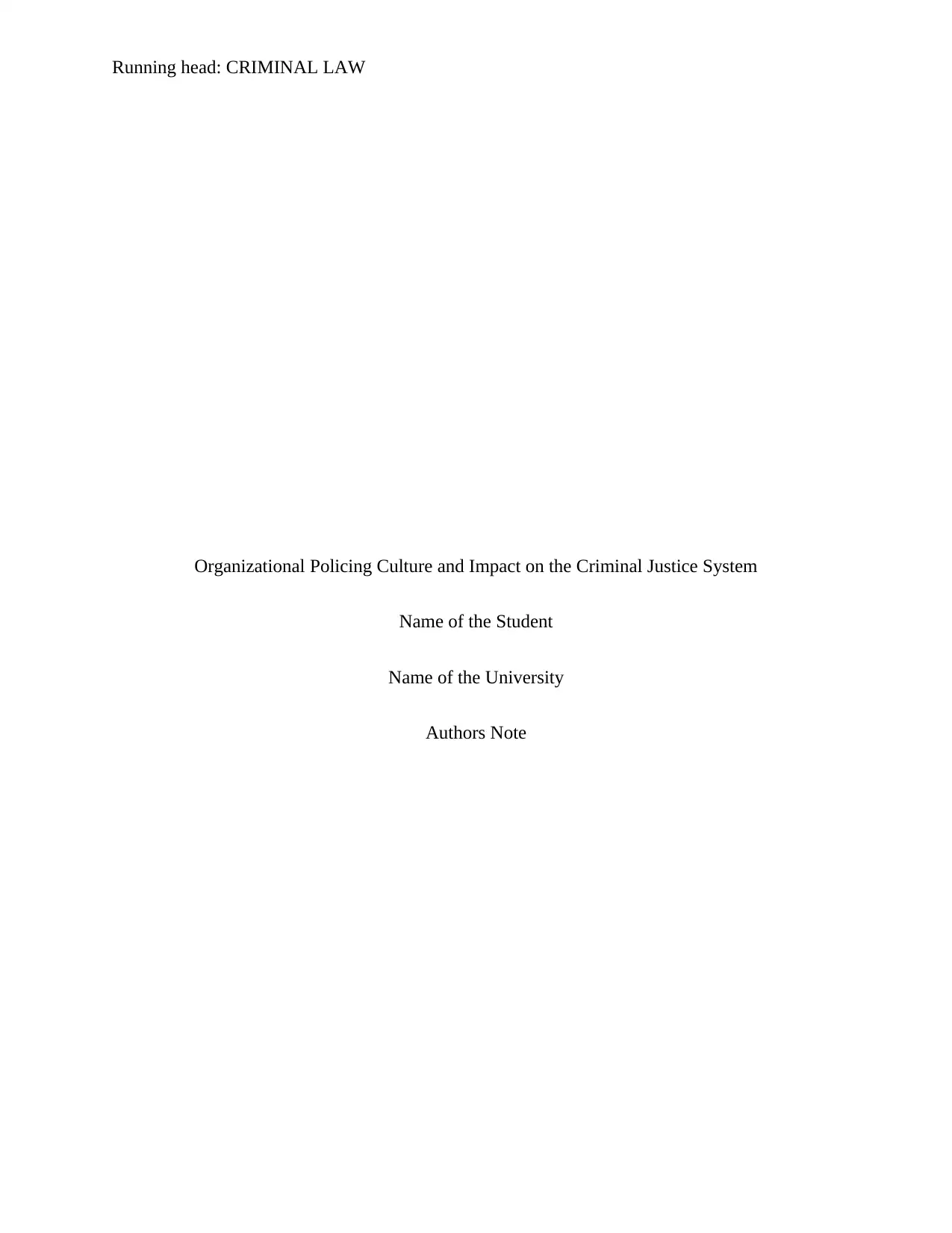
Running head: CRIMINAL LAW
Organizational Policing Culture and Impact on the Criminal Justice System
Name of the Student
Name of the University
Authors Note
Organizational Policing Culture and Impact on the Criminal Justice System
Name of the Student
Name of the University
Authors Note
Paraphrase This Document
Need a fresh take? Get an instant paraphrase of this document with our AI Paraphraser
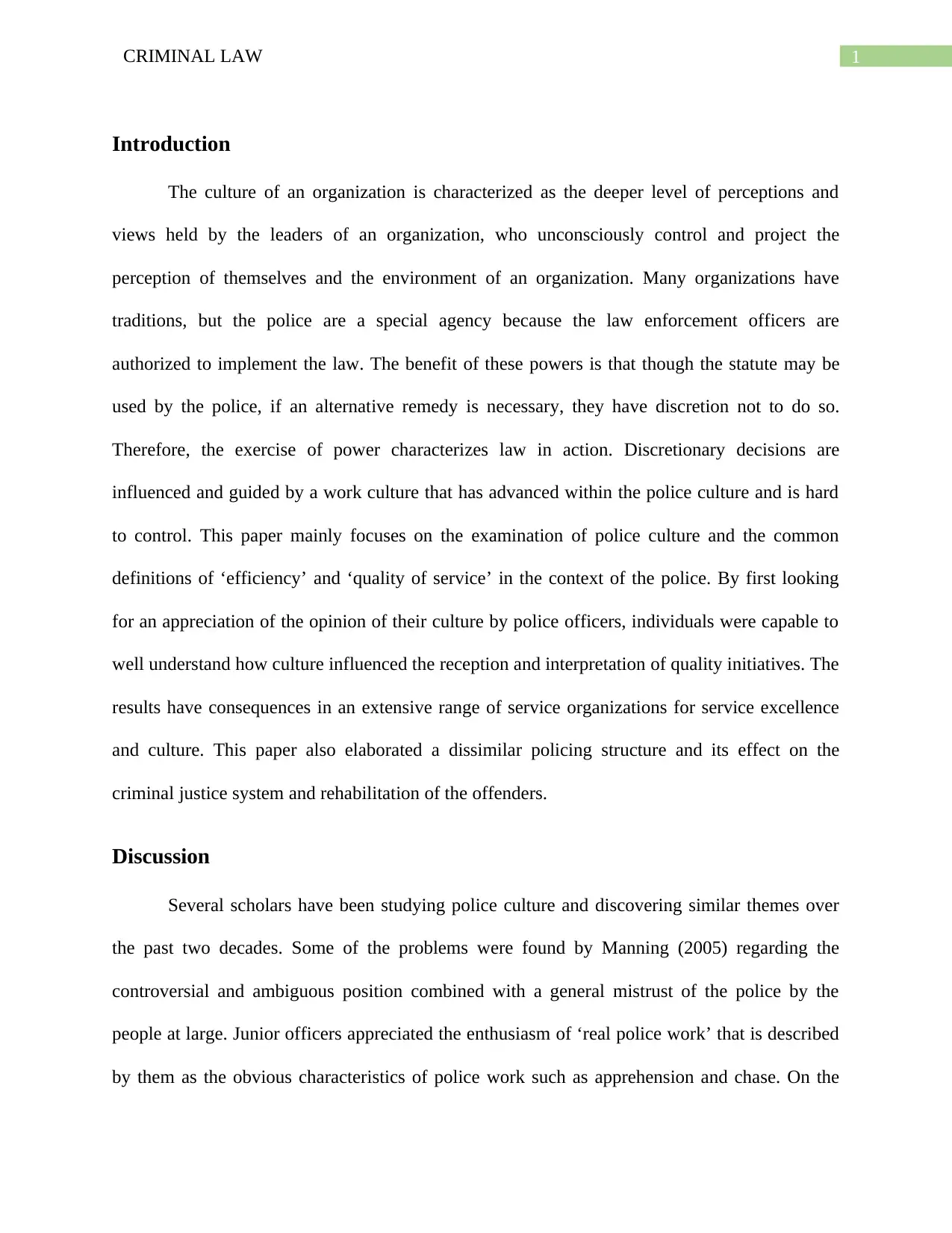
1CRIMINAL LAW
Introduction
The culture of an organization is characterized as the deeper level of perceptions and
views held by the leaders of an organization, who unconsciously control and project the
perception of themselves and the environment of an organization. Many organizations have
traditions, but the police are a special agency because the law enforcement officers are
authorized to implement the law. The benefit of these powers is that though the statute may be
used by the police, if an alternative remedy is necessary, they have discretion not to do so.
Therefore, the exercise of power characterizes law in action. Discretionary decisions are
influenced and guided by a work culture that has advanced within the police culture and is hard
to control. This paper mainly focuses on the examination of police culture and the common
definitions of ‘efficiency’ and ‘quality of service’ in the context of the police. By first looking
for an appreciation of the opinion of their culture by police officers, individuals were capable to
well understand how culture influenced the reception and interpretation of quality initiatives. The
results have consequences in an extensive range of service organizations for service excellence
and culture. This paper also elaborated a dissimilar policing structure and its effect on the
criminal justice system and rehabilitation of the offenders.
Discussion
Several scholars have been studying police culture and discovering similar themes over
the past two decades. Some of the problems were found by Manning (2005) regarding the
controversial and ambiguous position combined with a general mistrust of the police by the
people at large. Junior officers appreciated the enthusiasm of ‘real police work’ that is described
by them as the obvious characteristics of police work such as apprehension and chase. On the
Introduction
The culture of an organization is characterized as the deeper level of perceptions and
views held by the leaders of an organization, who unconsciously control and project the
perception of themselves and the environment of an organization. Many organizations have
traditions, but the police are a special agency because the law enforcement officers are
authorized to implement the law. The benefit of these powers is that though the statute may be
used by the police, if an alternative remedy is necessary, they have discretion not to do so.
Therefore, the exercise of power characterizes law in action. Discretionary decisions are
influenced and guided by a work culture that has advanced within the police culture and is hard
to control. This paper mainly focuses on the examination of police culture and the common
definitions of ‘efficiency’ and ‘quality of service’ in the context of the police. By first looking
for an appreciation of the opinion of their culture by police officers, individuals were capable to
well understand how culture influenced the reception and interpretation of quality initiatives. The
results have consequences in an extensive range of service organizations for service excellence
and culture. This paper also elaborated a dissimilar policing structure and its effect on the
criminal justice system and rehabilitation of the offenders.
Discussion
Several scholars have been studying police culture and discovering similar themes over
the past two decades. Some of the problems were found by Manning (2005) regarding the
controversial and ambiguous position combined with a general mistrust of the police by the
people at large. Junior officers appreciated the enthusiasm of ‘real police work’ that is described
by them as the obvious characteristics of police work such as apprehension and chase. On the
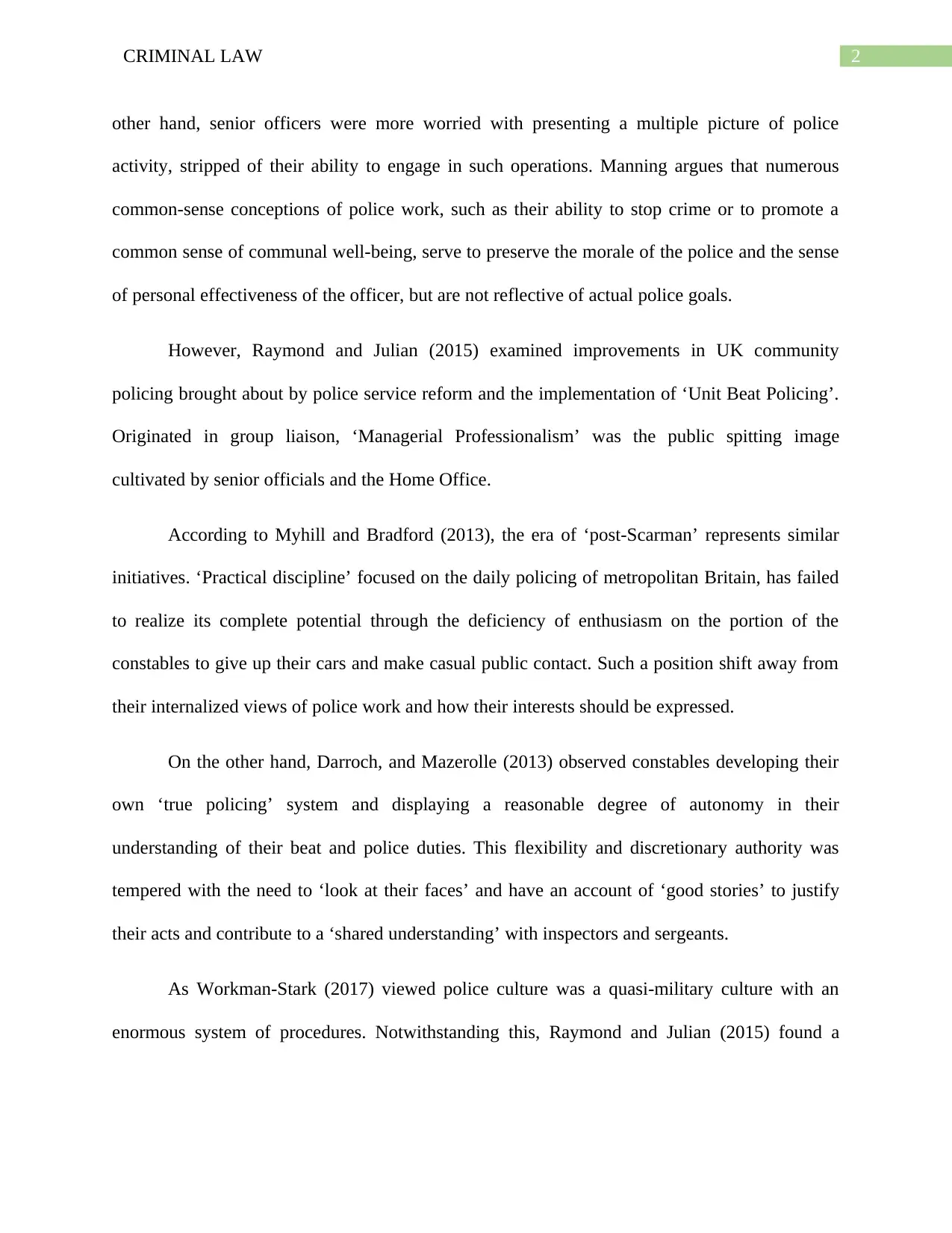
2CRIMINAL LAW
other hand, senior officers were more worried with presenting a multiple picture of police
activity, stripped of their ability to engage in such operations. Manning argues that numerous
common-sense conceptions of police work, such as their ability to stop crime or to promote a
common sense of communal well-being, serve to preserve the morale of the police and the sense
of personal effectiveness of the officer, but are not reflective of actual police goals.
However, Raymond and Julian (2015) examined improvements in UK community
policing brought about by police service reform and the implementation of ‘Unit Beat Policing’.
Originated in group liaison, ‘Managerial Professionalism’ was the public spitting image
cultivated by senior officials and the Home Office.
According to Myhill and Bradford (2013), the era of ‘post-Scarman’ represents similar
initiatives. ‘Practical discipline’ focused on the daily policing of metropolitan Britain, has failed
to realize its complete potential through the deficiency of enthusiasm on the portion of the
constables to give up their cars and make casual public contact. Such a position shift away from
their internalized views of police work and how their interests should be expressed.
On the other hand, Darroch, and Mazerolle (2013) observed constables developing their
own ‘true policing’ system and displaying a reasonable degree of autonomy in their
understanding of their beat and police duties. This flexibility and discretionary authority was
tempered with the need to ‘look at their faces’ and have an account of ‘good stories’ to justify
their acts and contribute to a ‘shared understanding’ with inspectors and sergeants.
As Workman-Stark (2017) viewed police culture was a quasi-military culture with an
enormous system of procedures. Notwithstanding this, Raymond and Julian (2015) found a
other hand, senior officers were more worried with presenting a multiple picture of police
activity, stripped of their ability to engage in such operations. Manning argues that numerous
common-sense conceptions of police work, such as their ability to stop crime or to promote a
common sense of communal well-being, serve to preserve the morale of the police and the sense
of personal effectiveness of the officer, but are not reflective of actual police goals.
However, Raymond and Julian (2015) examined improvements in UK community
policing brought about by police service reform and the implementation of ‘Unit Beat Policing’.
Originated in group liaison, ‘Managerial Professionalism’ was the public spitting image
cultivated by senior officials and the Home Office.
According to Myhill and Bradford (2013), the era of ‘post-Scarman’ represents similar
initiatives. ‘Practical discipline’ focused on the daily policing of metropolitan Britain, has failed
to realize its complete potential through the deficiency of enthusiasm on the portion of the
constables to give up their cars and make casual public contact. Such a position shift away from
their internalized views of police work and how their interests should be expressed.
On the other hand, Darroch, and Mazerolle (2013) observed constables developing their
own ‘true policing’ system and displaying a reasonable degree of autonomy in their
understanding of their beat and police duties. This flexibility and discretionary authority was
tempered with the need to ‘look at their faces’ and have an account of ‘good stories’ to justify
their acts and contribute to a ‘shared understanding’ with inspectors and sergeants.
As Workman-Stark (2017) viewed police culture was a quasi-military culture with an
enormous system of procedures. Notwithstanding this, Raymond and Julian (2015) found a
⊘ This is a preview!⊘
Do you want full access?
Subscribe today to unlock all pages.

Trusted by 1+ million students worldwide
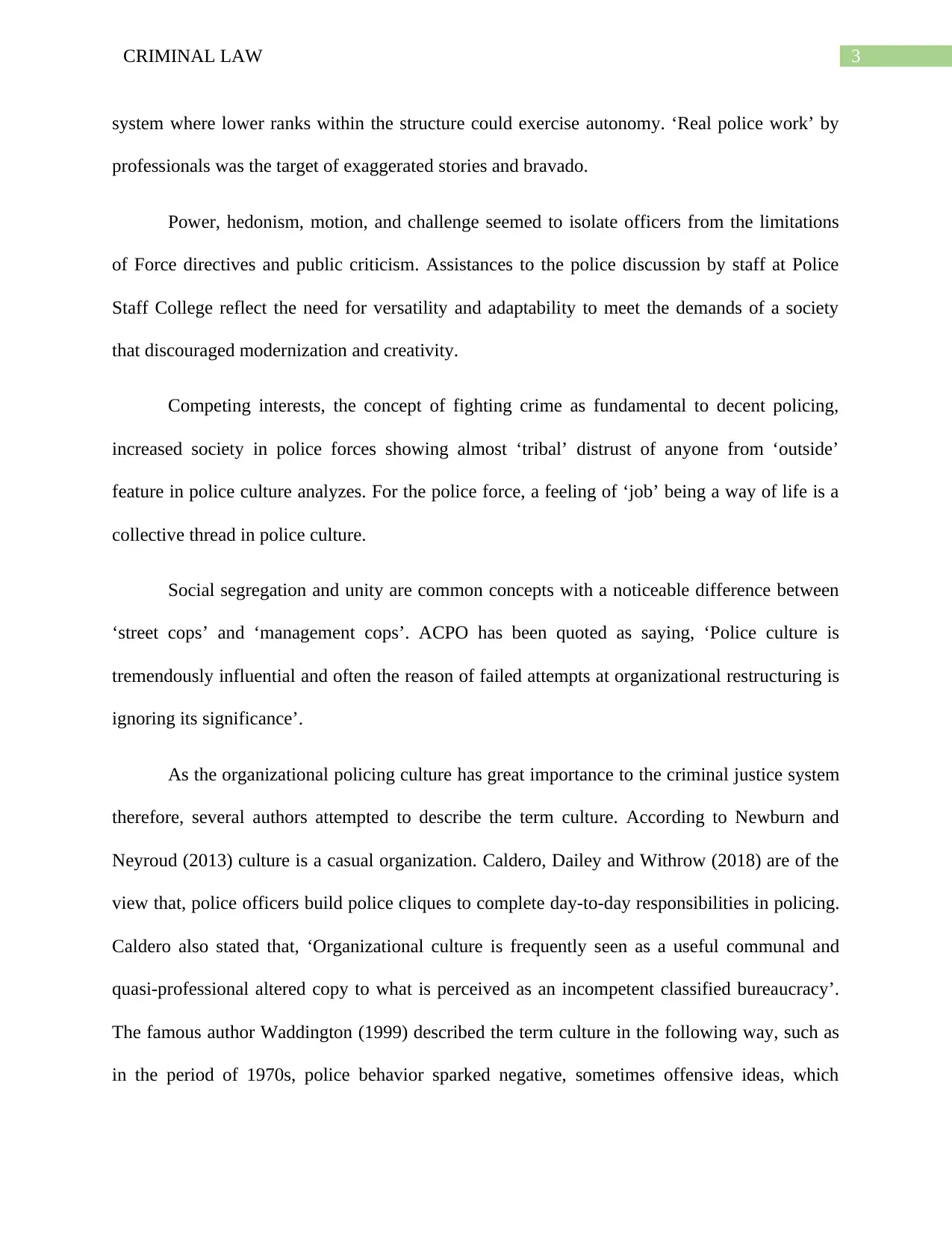
3CRIMINAL LAW
system where lower ranks within the structure could exercise autonomy. ‘Real police work’ by
professionals was the target of exaggerated stories and bravado.
Power, hedonism, motion, and challenge seemed to isolate officers from the limitations
of Force directives and public criticism. Assistances to the police discussion by staff at Police
Staff College reflect the need for versatility and adaptability to meet the demands of a society
that discouraged modernization and creativity.
Competing interests, the concept of fighting crime as fundamental to decent policing,
increased society in police forces showing almost ‘tribal’ distrust of anyone from ‘outside’
feature in police culture analyzes. For the police force, a feeling of ‘job’ being a way of life is a
collective thread in police culture.
Social segregation and unity are common concepts with a noticeable difference between
‘street cops’ and ‘management cops’. ACPO has been quoted as saying, ‘Police culture is
tremendously influential and often the reason of failed attempts at organizational restructuring is
ignoring its significance’.
As the organizational policing culture has great importance to the criminal justice system
therefore, several authors attempted to describe the term culture. According to Newburn and
Neyroud (2013) culture is a casual organization. Caldero, Dailey and Withrow (2018) are of the
view that, police officers build police cliques to complete day-to-day responsibilities in policing.
Caldero also stated that, ‘Organizational culture is frequently seen as a useful communal and
quasi-professional altered copy to what is perceived as an incompetent classified bureaucracy’.
The famous author Waddington (1999) described the term culture in the following way, such as
in the period of 1970s, police behavior sparked negative, sometimes offensive ideas, which
system where lower ranks within the structure could exercise autonomy. ‘Real police work’ by
professionals was the target of exaggerated stories and bravado.
Power, hedonism, motion, and challenge seemed to isolate officers from the limitations
of Force directives and public criticism. Assistances to the police discussion by staff at Police
Staff College reflect the need for versatility and adaptability to meet the demands of a society
that discouraged modernization and creativity.
Competing interests, the concept of fighting crime as fundamental to decent policing,
increased society in police forces showing almost ‘tribal’ distrust of anyone from ‘outside’
feature in police culture analyzes. For the police force, a feeling of ‘job’ being a way of life is a
collective thread in police culture.
Social segregation and unity are common concepts with a noticeable difference between
‘street cops’ and ‘management cops’. ACPO has been quoted as saying, ‘Police culture is
tremendously influential and often the reason of failed attempts at organizational restructuring is
ignoring its significance’.
As the organizational policing culture has great importance to the criminal justice system
therefore, several authors attempted to describe the term culture. According to Newburn and
Neyroud (2013) culture is a casual organization. Caldero, Dailey and Withrow (2018) are of the
view that, police officers build police cliques to complete day-to-day responsibilities in policing.
Caldero also stated that, ‘Organizational culture is frequently seen as a useful communal and
quasi-professional altered copy to what is perceived as an incompetent classified bureaucracy’.
The famous author Waddington (1999) described the term culture in the following way, such as
in the period of 1970s, police behavior sparked negative, sometimes offensive ideas, which
Paraphrase This Document
Need a fresh take? Get an instant paraphrase of this document with our AI Paraphraser
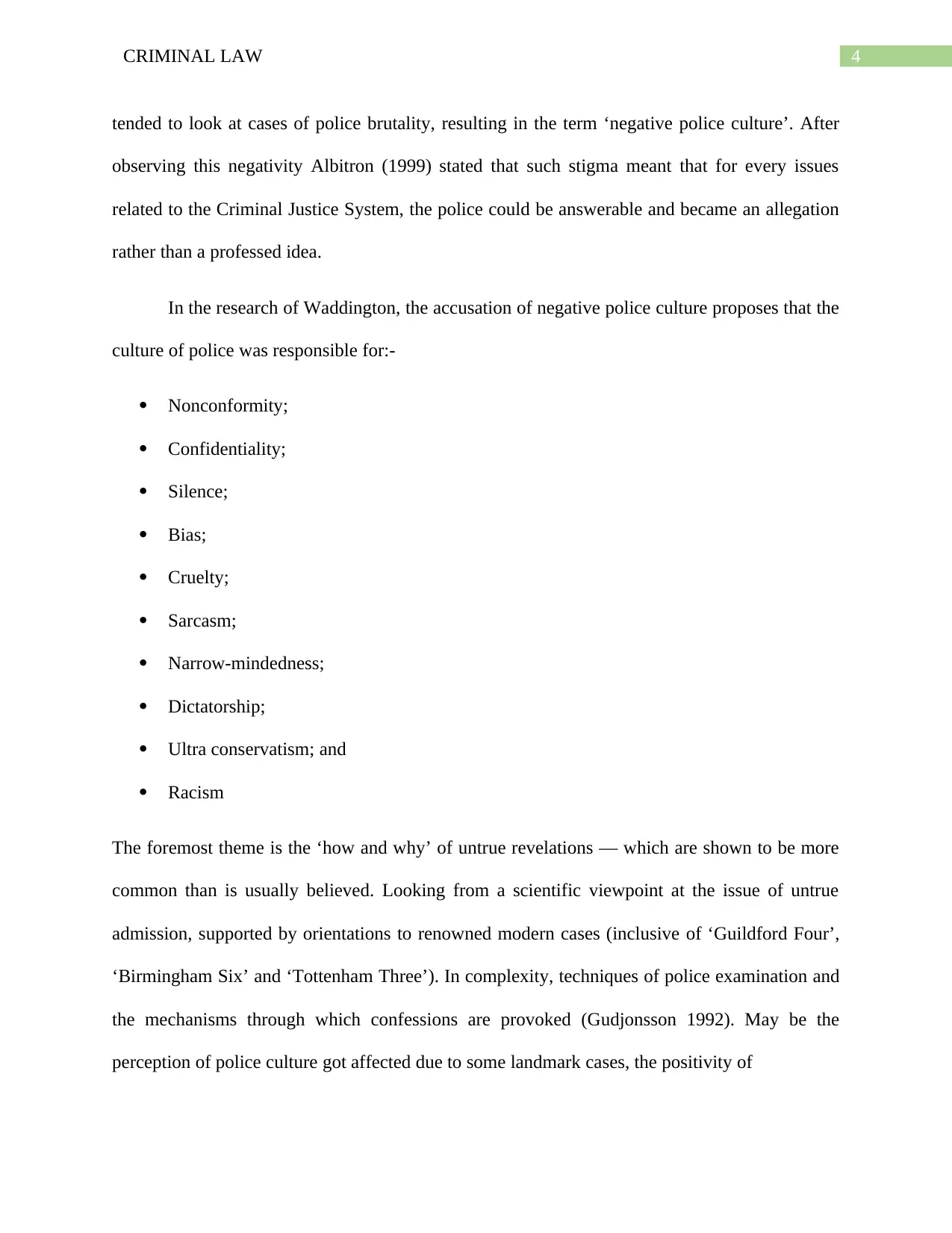
4CRIMINAL LAW
tended to look at cases of police brutality, resulting in the term ‘negative police culture’. After
observing this negativity Albitron (1999) stated that such stigma meant that for every issues
related to the Criminal Justice System, the police could be answerable and became an allegation
rather than a professed idea.
In the research of Waddington, the accusation of negative police culture proposes that the
culture of police was responsible for:-
Nonconformity;
Confidentiality;
Silence;
Bias;
Cruelty;
Sarcasm;
Narrow-mindedness;
Dictatorship;
Ultra conservatism; and
Racism
The foremost theme is the ‘how and why’ of untrue revelations — which are shown to be more
common than is usually believed. Looking from a scientific viewpoint at the issue of untrue
admission, supported by orientations to renowned modern cases (inclusive of ‘Guildford Four’,
‘Birmingham Six’ and ‘Tottenham Three’). In complexity, techniques of police examination and
the mechanisms through which confessions are provoked (Gudjonsson 1992). May be the
perception of police culture got affected due to some landmark cases, the positivity of
tended to look at cases of police brutality, resulting in the term ‘negative police culture’. After
observing this negativity Albitron (1999) stated that such stigma meant that for every issues
related to the Criminal Justice System, the police could be answerable and became an allegation
rather than a professed idea.
In the research of Waddington, the accusation of negative police culture proposes that the
culture of police was responsible for:-
Nonconformity;
Confidentiality;
Silence;
Bias;
Cruelty;
Sarcasm;
Narrow-mindedness;
Dictatorship;
Ultra conservatism; and
Racism
The foremost theme is the ‘how and why’ of untrue revelations — which are shown to be more
common than is usually believed. Looking from a scientific viewpoint at the issue of untrue
admission, supported by orientations to renowned modern cases (inclusive of ‘Guildford Four’,
‘Birmingham Six’ and ‘Tottenham Three’). In complexity, techniques of police examination and
the mechanisms through which confessions are provoked (Gudjonsson 1992). May be the
perception of police culture got affected due to some landmark cases, the positivity of
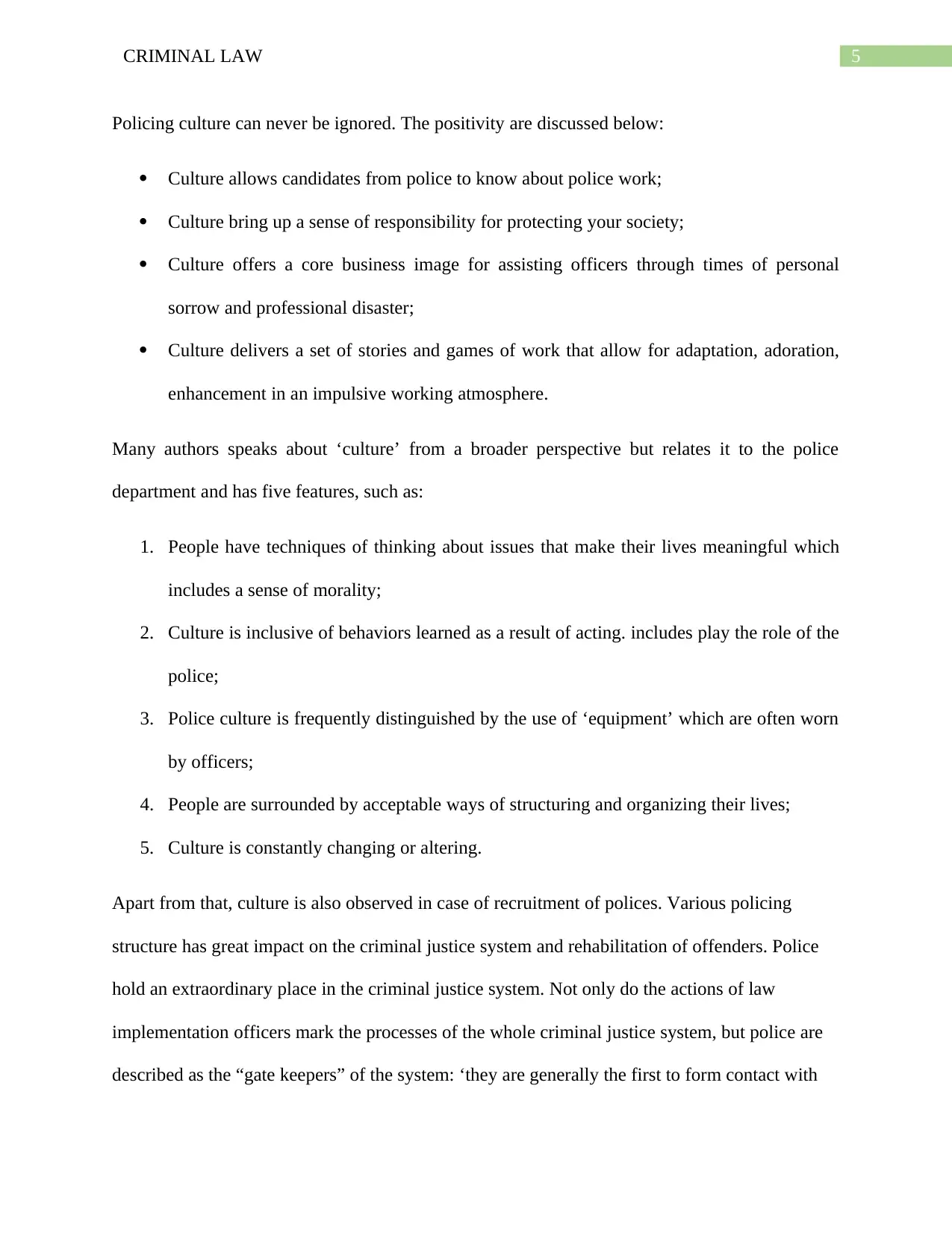
5CRIMINAL LAW
Policing culture can never be ignored. The positivity are discussed below:
Culture allows candidates from police to know about police work;
Culture bring up a sense of responsibility for protecting your society;
Culture offers a core business image for assisting officers through times of personal
sorrow and professional disaster;
Culture delivers a set of stories and games of work that allow for adaptation, adoration,
enhancement in an impulsive working atmosphere.
Many authors speaks about ‘culture’ from a broader perspective but relates it to the police
department and has five features, such as:
1. People have techniques of thinking about issues that make their lives meaningful which
includes a sense of morality;
2. Culture is inclusive of behaviors learned as a result of acting. includes play the role of the
police;
3. Police culture is frequently distinguished by the use of ‘equipment’ which are often worn
by officers;
4. People are surrounded by acceptable ways of structuring and organizing their lives;
5. Culture is constantly changing or altering.
Apart from that, culture is also observed in case of recruitment of polices. Various policing
structure has great impact on the criminal justice system and rehabilitation of offenders. Police
hold an extraordinary place in the criminal justice system. Not only do the actions of law
implementation officers mark the processes of the whole criminal justice system, but police are
described as the “gate keepers” of the system: ‘they are generally the first to form contact with
Policing culture can never be ignored. The positivity are discussed below:
Culture allows candidates from police to know about police work;
Culture bring up a sense of responsibility for protecting your society;
Culture offers a core business image for assisting officers through times of personal
sorrow and professional disaster;
Culture delivers a set of stories and games of work that allow for adaptation, adoration,
enhancement in an impulsive working atmosphere.
Many authors speaks about ‘culture’ from a broader perspective but relates it to the police
department and has five features, such as:
1. People have techniques of thinking about issues that make their lives meaningful which
includes a sense of morality;
2. Culture is inclusive of behaviors learned as a result of acting. includes play the role of the
police;
3. Police culture is frequently distinguished by the use of ‘equipment’ which are often worn
by officers;
4. People are surrounded by acceptable ways of structuring and organizing their lives;
5. Culture is constantly changing or altering.
Apart from that, culture is also observed in case of recruitment of polices. Various policing
structure has great impact on the criminal justice system and rehabilitation of offenders. Police
hold an extraordinary place in the criminal justice system. Not only do the actions of law
implementation officers mark the processes of the whole criminal justice system, but police are
described as the “gate keepers” of the system: ‘they are generally the first to form contact with
⊘ This is a preview!⊘
Do you want full access?
Subscribe today to unlock all pages.

Trusted by 1+ million students worldwide
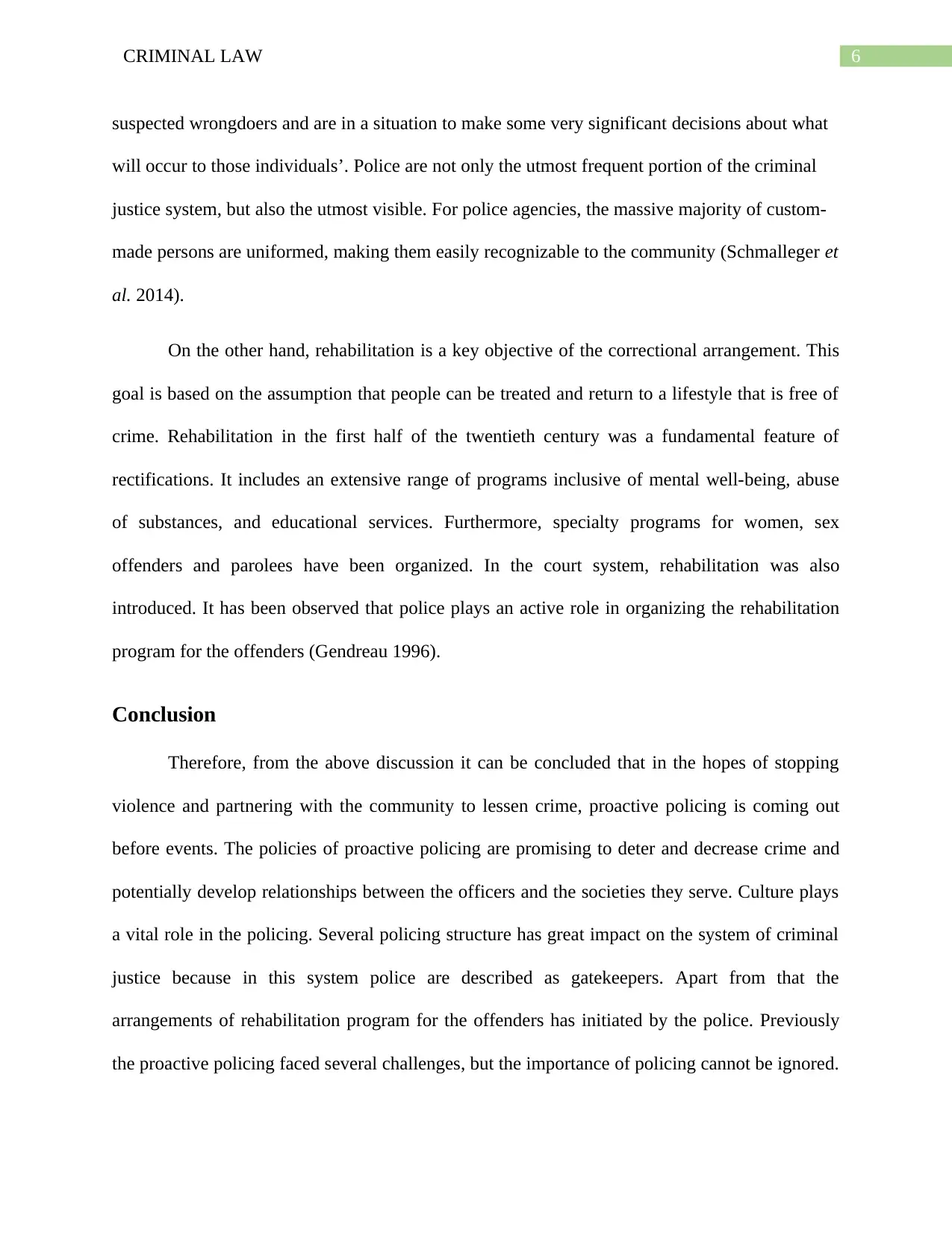
6CRIMINAL LAW
suspected wrongdoers and are in a situation to make some very significant decisions about what
will occur to those individuals’. Police are not only the utmost frequent portion of the criminal
justice system, but also the utmost visible. For police agencies, the massive majority of custom-
made persons are uniformed, making them easily recognizable to the community (Schmalleger et
al. 2014).
On the other hand, rehabilitation is a key objective of the correctional arrangement. This
goal is based on the assumption that people can be treated and return to a lifestyle that is free of
crime. Rehabilitation in the first half of the twentieth century was a fundamental feature of
rectifications. It includes an extensive range of programs inclusive of mental well-being, abuse
of substances, and educational services. Furthermore, specialty programs for women, sex
offenders and parolees have been organized. In the court system, rehabilitation was also
introduced. It has been observed that police plays an active role in organizing the rehabilitation
program for the offenders (Gendreau 1996).
Conclusion
Therefore, from the above discussion it can be concluded that in the hopes of stopping
violence and partnering with the community to lessen crime, proactive policing is coming out
before events. The policies of proactive policing are promising to deter and decrease crime and
potentially develop relationships between the officers and the societies they serve. Culture plays
a vital role in the policing. Several policing structure has great impact on the system of criminal
justice because in this system police are described as gatekeepers. Apart from that the
arrangements of rehabilitation program for the offenders has initiated by the police. Previously
the proactive policing faced several challenges, but the importance of policing cannot be ignored.
suspected wrongdoers and are in a situation to make some very significant decisions about what
will occur to those individuals’. Police are not only the utmost frequent portion of the criminal
justice system, but also the utmost visible. For police agencies, the massive majority of custom-
made persons are uniformed, making them easily recognizable to the community (Schmalleger et
al. 2014).
On the other hand, rehabilitation is a key objective of the correctional arrangement. This
goal is based on the assumption that people can be treated and return to a lifestyle that is free of
crime. Rehabilitation in the first half of the twentieth century was a fundamental feature of
rectifications. It includes an extensive range of programs inclusive of mental well-being, abuse
of substances, and educational services. Furthermore, specialty programs for women, sex
offenders and parolees have been organized. In the court system, rehabilitation was also
introduced. It has been observed that police plays an active role in organizing the rehabilitation
program for the offenders (Gendreau 1996).
Conclusion
Therefore, from the above discussion it can be concluded that in the hopes of stopping
violence and partnering with the community to lessen crime, proactive policing is coming out
before events. The policies of proactive policing are promising to deter and decrease crime and
potentially develop relationships between the officers and the societies they serve. Culture plays
a vital role in the policing. Several policing structure has great impact on the system of criminal
justice because in this system police are described as gatekeepers. Apart from that the
arrangements of rehabilitation program for the offenders has initiated by the police. Previously
the proactive policing faced several challenges, but the importance of policing cannot be ignored.
Paraphrase This Document
Need a fresh take? Get an instant paraphrase of this document with our AI Paraphraser

7CRIMINAL LAW
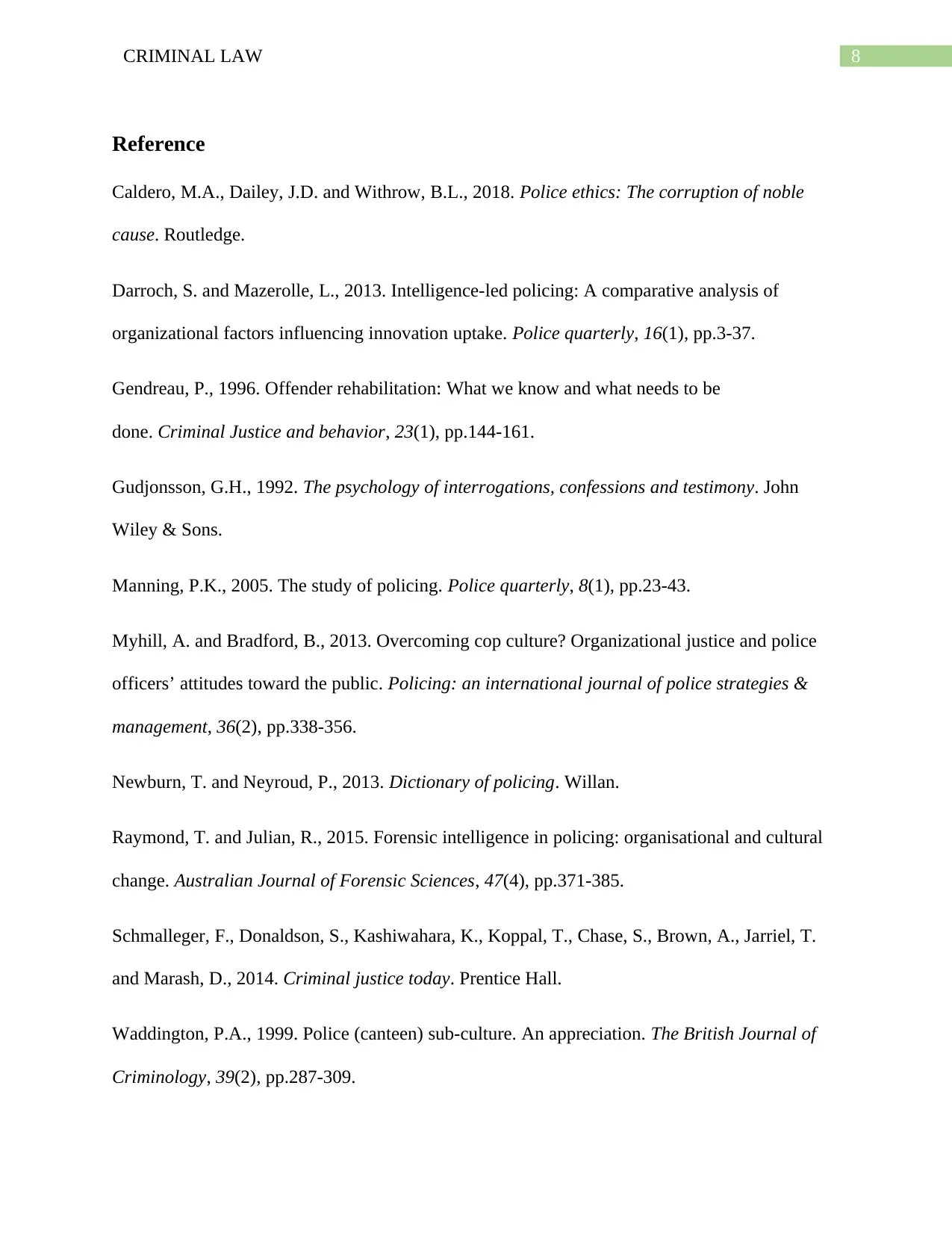
8CRIMINAL LAW
Reference
Caldero, M.A., Dailey, J.D. and Withrow, B.L., 2018. Police ethics: The corruption of noble
cause. Routledge.
Darroch, S. and Mazerolle, L., 2013. Intelligence-led policing: A comparative analysis of
organizational factors influencing innovation uptake. Police quarterly, 16(1), pp.3-37.
Gendreau, P., 1996. Offender rehabilitation: What we know and what needs to be
done. Criminal Justice and behavior, 23(1), pp.144-161.
Gudjonsson, G.H., 1992. The psychology of interrogations, confessions and testimony. John
Wiley & Sons.
Manning, P.K., 2005. The study of policing. Police quarterly, 8(1), pp.23-43.
Myhill, A. and Bradford, B., 2013. Overcoming cop culture? Organizational justice and police
officers’ attitudes toward the public. Policing: an international journal of police strategies &
management, 36(2), pp.338-356.
Newburn, T. and Neyroud, P., 2013. Dictionary of policing. Willan.
Raymond, T. and Julian, R., 2015. Forensic intelligence in policing: organisational and cultural
change. Australian Journal of Forensic Sciences, 47(4), pp.371-385.
Schmalleger, F., Donaldson, S., Kashiwahara, K., Koppal, T., Chase, S., Brown, A., Jarriel, T.
and Marash, D., 2014. Criminal justice today. Prentice Hall.
Waddington, P.A., 1999. Police (canteen) sub-culture. An appreciation. The British Journal of
Criminology, 39(2), pp.287-309.
Reference
Caldero, M.A., Dailey, J.D. and Withrow, B.L., 2018. Police ethics: The corruption of noble
cause. Routledge.
Darroch, S. and Mazerolle, L., 2013. Intelligence-led policing: A comparative analysis of
organizational factors influencing innovation uptake. Police quarterly, 16(1), pp.3-37.
Gendreau, P., 1996. Offender rehabilitation: What we know and what needs to be
done. Criminal Justice and behavior, 23(1), pp.144-161.
Gudjonsson, G.H., 1992. The psychology of interrogations, confessions and testimony. John
Wiley & Sons.
Manning, P.K., 2005. The study of policing. Police quarterly, 8(1), pp.23-43.
Myhill, A. and Bradford, B., 2013. Overcoming cop culture? Organizational justice and police
officers’ attitudes toward the public. Policing: an international journal of police strategies &
management, 36(2), pp.338-356.
Newburn, T. and Neyroud, P., 2013. Dictionary of policing. Willan.
Raymond, T. and Julian, R., 2015. Forensic intelligence in policing: organisational and cultural
change. Australian Journal of Forensic Sciences, 47(4), pp.371-385.
Schmalleger, F., Donaldson, S., Kashiwahara, K., Koppal, T., Chase, S., Brown, A., Jarriel, T.
and Marash, D., 2014. Criminal justice today. Prentice Hall.
Waddington, P.A., 1999. Police (canteen) sub-culture. An appreciation. The British Journal of
Criminology, 39(2), pp.287-309.
⊘ This is a preview!⊘
Do you want full access?
Subscribe today to unlock all pages.

Trusted by 1+ million students worldwide
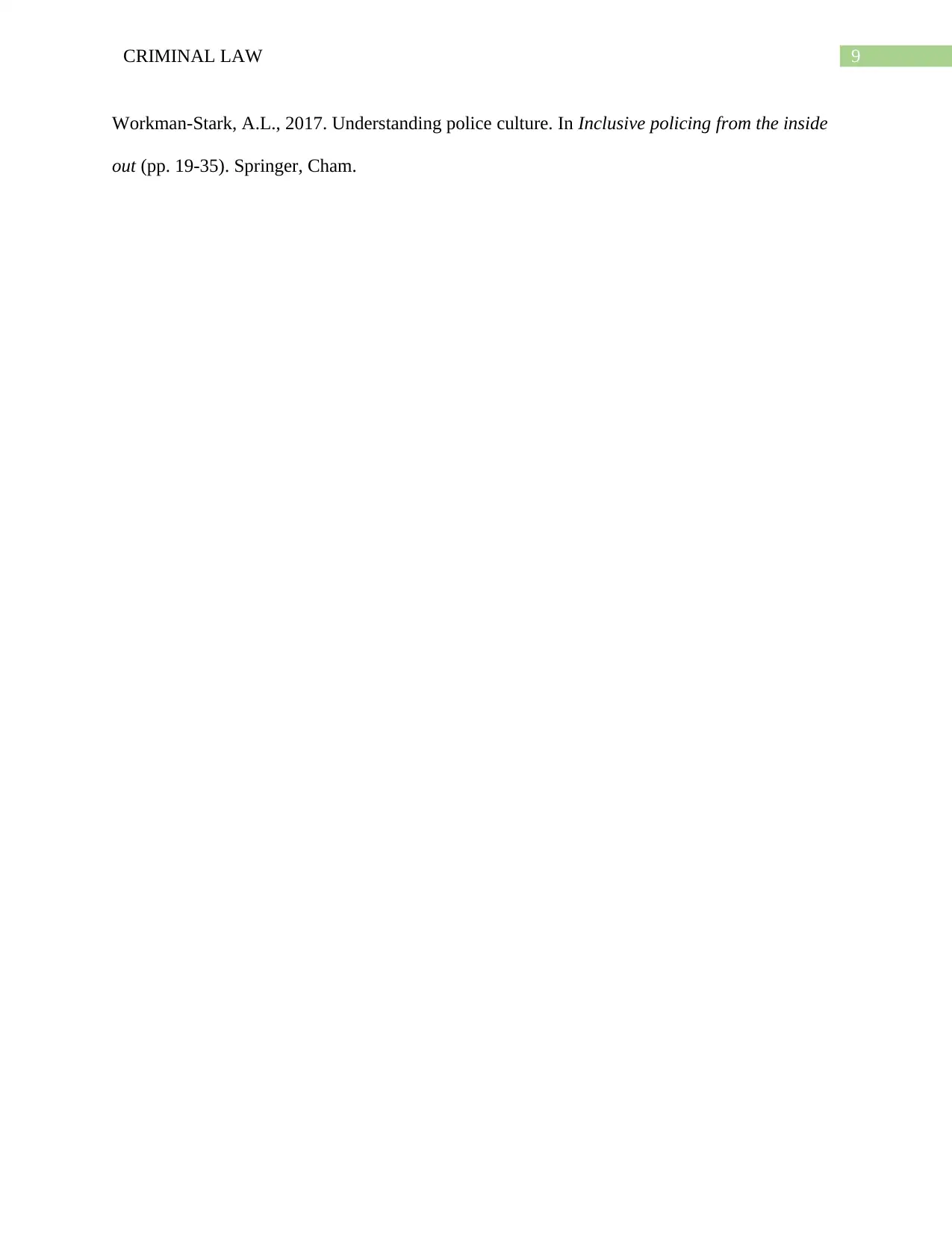
9CRIMINAL LAW
Workman-Stark, A.L., 2017. Understanding police culture. In Inclusive policing from the inside
out (pp. 19-35). Springer, Cham.
Workman-Stark, A.L., 2017. Understanding police culture. In Inclusive policing from the inside
out (pp. 19-35). Springer, Cham.
1 out of 10
Your All-in-One AI-Powered Toolkit for Academic Success.
+13062052269
info@desklib.com
Available 24*7 on WhatsApp / Email
![[object Object]](/_next/static/media/star-bottom.7253800d.svg)
Unlock your academic potential
Copyright © 2020–2025 A2Z Services. All Rights Reserved. Developed and managed by ZUCOL.

